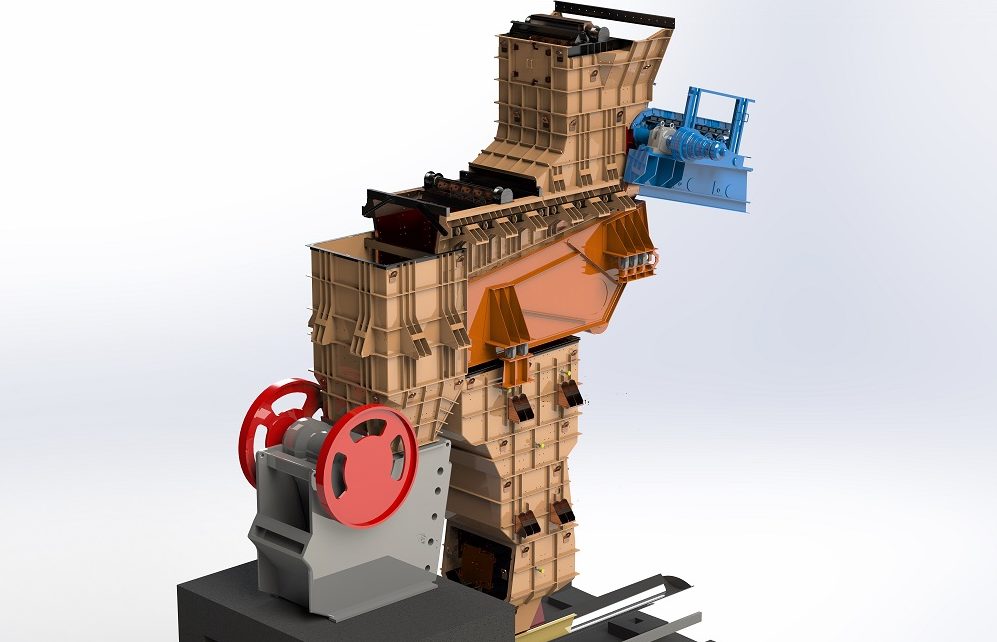Weba Chute Systems recent solution at a diamond mine in Botswana has tackled the issue of large particle sizes to ensure more uptime for the customer’s operation.
The mine had been faced with replacing transfer chutes almost every three months, as they could not withstand the arduous operating conditions. Run-of-mine material with lump sizes up to 1,200 mm was fed via an apron feeder onto a grizzly feeder, with the oversize material reporting to the jaw crusher.
The large size of the lump kimberlite in this application – as well as material being uncontrolled – posed an ongoing challenge to the transfer system. Another challenge in this primary circuit was that the conveyor receives material from the grizzly underpan and jaw crusher discharge, and lack of material control had resulted in high impact onto the conveyor belt. This damaged the conveyor and caused considerable spillage, resulting in unplanned downtime as the conveyor belt had to be replaced just about every quarter, according to Weba.
“The added expenditure and lost productivity meant increased operating costs for the plant, and eventually led to a decision to address the total material transfer system. The technical team from Weba Chute Systems assessed the challenges being faced and, in close collaboration with the mine, engineered a material handling solution,” Weba said.
Dewald Tintinger, Technical Manager at Weba Chute Systems, said: “Dealing with challenging applications – and in particular uncontrolled material flow – is something we are known for; we are often called in to assist plants where a standard one-size-fits-all solution has proved inadequate to their specific material handling needs.”
According to Tintinger, standard solutions for transfer points do not consider factors such as lump size and material velocity, or the general arrangement of the transfer point and the relationship between the equipment that feeds and receives material.
“Custom-engineered transfer points, on the other hand, are designed to deal specifically with individual materials handling applications,” he said. “They offer major advantages to a plant, but these often only become apparent after the basic chute systems have failed.”
In Weba’s solution for the diamond mine, the transfer chute that moves material from the apron feeder to the grizzly feeder incorporates an innovative patented mechanism that overcomes the challenges of handling the 1,200 mm lump sizes.
Tintinger said: “An integral swing mechanism – engineered to guide these large lump sizes through the transfer point at a controlled velocity – reduces the impact on downstream equipment. The next chute in the process flow therefore no longer has to deal with excessive impact, as this has been addressed through the swing mechanism in the first chute. The material then flows through the grizzly discharge chute and reports to the crusher.”
The combination of an engineered transfer point – with the swing mechanism in this position – has drastically reduced high impact and excessive wear previously experienced, according to Weba. The chute’s longevity has been dramatically improved, and has not required replacement since its installation over a year ago.
The grizzly underpan chute system handles lump sizes of minus 250 mm and has been designed to accommodate this material. With a drop height from the grizzly feeder to the conveyor of about 7 m – and with lump sizes of up to minus 250 mm – this could become a challenging transfer point.
Tintinger said: “Applying an engineered transfer point solution here was critical to the success of this material handling operation. The chute design accommodates the material flow in such a manner that it is absolutely controlled and excessive damage is no longer caused to the receiving conveyor.”
The crusher discharge chute is the final of the four engineered transfer solutions; while the same engineering principle as the third chute has been applied here, the drop is not as far. The combination of these two chutes has significantly reduced material impact onto the conveyor and has substantially increased belt life.











